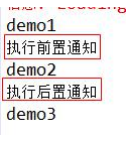目录
一:AOP
1、 AOP:中文名称 面向切面编程 (Aspect Oriented Programming)
2、正常程序执行流程都是纵向执行流程
2.1 又叫面向切面编程,在原有纵向执行流程中添加切面
2.2 不需要修改原有程序代码
高扩展性
原有的功能相当于释放了部分逻辑,让职责更加明确!

3、 面向切面编程是什么?
3.1 在原有程序纵向执行的流程中,针对某一个或某一些方法添加通知,形成横切面过程就叫做面向切面编程。
4、常用概念
4.1 原有功能: 切点
4.2 前置通知: 在切点之前执行的功能,before advice。
4.3 后置通知:在切点之后执行的功能,after advice。
如果切点在执行过程中出现异常,则会出发异常通知,throws advice
所有的功能叫做 切面
4.4 织入: 把切面嵌入到原有功能的过程叫做织入
5、Spring提供两种AOP实现方式
5.1 Schema-based
每个通知都需要实现接口或者类。
配置Spring配置文件时在 <aop:config>配置
5.2 AspectJ
每个通知不需要实现接口或者类
配置Spring配置文件是在 <aop:config>的子标签 <aop : aspect>中配置。
二:Schema-based 实现步骤
1、导入jar包(组件包 aopliance.jar 和 aspectjweaver.jar)
2、新建通知类
2.1 新建前置通知类(实现 MethodBeforeAdvice)
arg0 : 切点方法对象 Method
arg1: 切点方法参数
arg2: 切点在哪个对象中
public class MyBeforeAdvice implements MethodBeforeAdvice {
@Override
public void before(Method arg0, Object[] arg1, Object arg2) throws Throwable {
System.out.println("执行前置通知");
}
}
2.2 新建后置通知类 (实现 AfterReturningAdvice)
arg0: 切点方法返回值
arg1: 切点方法对象
arg2: 切点方法参数
arg3: 切点方法所在类的对象
public class MyAfterAdvice implements AfterReturningAdvice {
@Override
public void afterReturning(Object arg0, Method arg1, Object[] arg2, Object arg3) throws Throwable {
System.out.println("执行后置通知");
}
}
3、配置 Spring 配置文件
3.1 引入aop命名空间
3.2 配置通知类 Bean
3.3 配置切面
3.4 * 是通配符,匹配任意方法名,任意类名,任意一级别的包名。
3.5 如果想匹配任意一参数,可以在方法中添加 (..)
<?xml version="1.0" encoding="UTF-8"?>
<beans
xmlns="http://www.springframework.org/schema/beans"
xmlns:xsi="http://www.w3.org/2001/XMLSchema-instance"
xmlns:aop="http://www.springframework.org/schema/aop"
xsi:schemaLocation="http://www.springframework.org/schema/beans
http://www.springframework.org/schema/beans/spring-beans.xsd
http://www.springframework.org/schema/aop
http://www.springframework.org/schema/aop/spring-aop.
xsd">
<!-- 配置通知类对象,在切面中引入 -->
<bean id="mybefore" class="com.bjsxt.advice.MyBeforeAdvice"></bean>
<bean id="myafter" class="com.bjsxt.advice.MyAfterAdvice"></bean>
<!-- 配置切面 -->
<aop:config>
<!-- 配置切点 -->
<aop:pointcut expression="execution(* com.bjsxt.test.Demo.demo2())" id="mypoint"/>
<!-- 通知 -->
<aop:advisor advice-ref="mybefore" pointcut-ref="mypoint"/>
<aop:advisor advice-ref="myafter" pointcut-ref="mypoint"/>
</aop:config>
<!-- 配置 Demo 类,测试使用 -->
<bean id="demo" class="com.bjsxt.test.Demo"></bean>
</beans>
4、 编写测试代码
public class Test{
public static void main(String[] args){
/**加载配置文件**/
ApplicationContext ac=new ClassPathXmlApplicationContext("applicationContext.xml");
//获取Spring管理的对象
Demo demo=ac.getBean("demo",Demo.class);
demo.demo1();
demo.demo2();
demo.demo3();
}
}5、 运行结果

三:AspectJ实现方式(异常通知)
(对通知类的要求特别低,但是对配置文件的要求也特别高!!)
1、 只有当切点报异常才能触发异常通知,
2、在Spring中有AspectJ方式提供了异常通知的办法
2.1 如果希望通过 schema-base 实现 需要按照特定的要求自己编写方法.
3、 实现步骤
3.1 新建异常通知类,在类中写任意名称的方法
public class MyThrowAdvice{
public void myexception(Exception e1){
System.out.println("执行异常通知"+e1.getMessage());
}
}
3.2 在spring 配置文件中配置
<aop:aspect ref=""> 的ref 属性表示:方法在哪个类中。
<aop:after-throwing method="" throwing="" /> 表示什么后置通知,method表示当触发这个通知时,调用哪个方法!throwing:异常对象名,必须和通知中方法参数名相同(可以不在通知中声明异常对象。)
<bean id="mythrow" class="com.bjsxt.advice.MyThrowAdvice"></bean>
<aop:config>
<aop:aspect ref="mythrow">
<aop:pointcut expression="execution(* com.bjsxt.test.Demo.demo1())" id="mypoint"/>
<aop:after-throwing method="myexception" pointcut-ref="mypoint" throwing="e1"/>
</aop:aspect>
</aop:config>
<bean id="demo" class="com.bjsxt.test.Demo"></bean>
四:异常通知(Schema-base方式)
1、新建一个异常通知类 并实现 throwsAdvice 接口
1.1 必须自己写方法,且方法名字为 afterThrowing
1.2 有两种参数方式
必须4个是1个或者
1.3 异常类型要与切点报的异常类型一致
public class MyThrow implements ThrowsAdvice{
public void afterThrowing(Exception ex) throws Throwable {
System.out.println("执行异常通过-schema-base 方式");
}
}
2、 在ApplicationContext.xml 配置
<bean id="mythrow" class="com.bjsxt.advice.MyThrow"></bean> //方法名一定要是 afterThroeing
<aop:config>
<aop:pointcut expression="execution(* com.bjsxt.test.Demo.demo1())" id="mypoint"/>
<aop:advisor advice-ref="mythrow" pointcut-ref="mypoint" />
</aop:config>
<bean id="demo" class="com.bjsxt.test.Demo"></bean>
五:环绕通知(Schema-base方式)
1、大概内容就是把 前置通知和后置通知放在一个通知类中,组成环绕通知
2、实现步骤
2.1 新建一个类实现 MethodInterceptor
public class MyArround implements MethodInterceptor {
@Override
public Object invoke(MethodInvocation arg0) throws Throwable {
System.out.println("环绕-前置");
Object result = arg0.proceed();//放行,调用切点方法
System.out.println("环绕-后置");
return result;
}
}2.2 配置 ApplicatonContext.xml
<bean id="myarround" class="com.bjsxt.advice.MyArround"></bean> //配置通知类
<aop:config>
//配置切点
<aop:pointcut expression="execution(* com.bjsxt.test.Demo.demo1())" id="mypoint"/>
<aop:advisor advice-ref="myarround"pointcut-ref="mypoint" />
</aop:config>
<bean id="demo" class="com.bjsxt.test.Demo"></bean>
六:环绕通知(AspectJ方式实现)
1、新建类不用实现任何东西( 这就是AspectJ方式对通知类的要求很低!)
1.1 类中方法名任意。
public class MyAdvice {
public void mybefore(String name1, int age1) { //前置1 参数为两个
System.out.println("前置" + name1);
}
public void mybefore1(String name1) { //前置2 参数为一个
System.out.println("前置:" + name1);
}
public void myaftering() { //afterreturning 只有在切点方法正常执行下才触发
System.out.println("后置 2");
}
public void myafter() { //任何情况下都会触发!
System.out.println("后置 1");
}
public void mythrow() { //AspectJ 方式下的异常通知
System.out.println("异常");
}
//环绕通知 参数为 ProceedingJoinPoint
public Object myarround(ProceedingJoinPoint p) throws Throwable {
System.out.println("执行环绕");
System.out.println("环绕-前置");
Object result = p.proceed();
System.out.println("环绕后置");
return result;
}
1.2 配置Spring 配置文件
1<aop:after/> 后置通知,是否出现异常都执行!
2<aop:after-returing/> 后置通知,只有当切点正常执行时执行!
3<aop:after/>&&<aop:after-returing/>&&<aop:after-throwing/> 三者的执行顺序跟xml中的配置顺序有关
4excution()括号不能扩上args参数, execution(* com.bjsxt.test.Demo.demo1(String,int)) and args(name1,age1) , 中间使用 and 不能使用 && 由Spring 把 and 解析成 && 。
arg(名称)名称自定义的 顺序 和 demo1(切点方法)(参数,参数) 必须对应,
重点:5 <aop:before/> arg-names=" 名称" 来源于 excution=" " 中的 args(),同时arg-names=" 名称"必须和通知方法参数名对应!
<aop:config>
<aop:aspect ref="myadvice">
<aop:pointcut expression="execution(* com.bjsxt.test.Demo.demo1(String,int))and args(name1,age1)" id="mypoint"/> //切点 1
<aop:pointcut expression="execution(* com.bjsxt.test.Demo.demo1(String)) and args(name1)" id="mypoint1"/> //切点 2
<aop:before method="mybefore" pointcut-ref="mypoint" arg-names="name1,age1"/>
<aop:before method="mybefore1" pointcut-ref="mypoint1" arg-names="name1"/>
<!-- <aop:after method="myafter"
pointcut-ref="mypoint"/>
<aop:after-returning method="myaftering"
pointcut-ref="mypoint"/>
<aop:after-throwing method="mythrow"
pointcut-ref="mypoint"/>
<aop:around method="myarround"
pointcut-ref="mypoint"/>-->
</aop:aspect>
</aop:config>
七:使用注解(基于AspectJ方式)
1、 Spring 不会自动去寻找注解,必须告诉Spring哪些包下的类中可能由注解
1.1 解决办法:引入 xmlns:context
<context:component-scan base-package="com.bjsxt.advice"></context:component-scan>
2、Component
2.1 相当于 <bean/>
2.2 如果没有参数的话,把类名首字母变小写,相当于<bean id=" "/>
2.3 @Component("自定义名称")
3、实现步骤:
3.1 在Spring配置文件中设置注解在哪些包下
<context:component-scan base-package="com.bjsxt.advice,com.bjsxt.test"></context:component-scan>
3.2 在Demo类中添加 注解 @Componet
在方法上添加@Pointcut("")定义切点
@Component
public class Demo{
@Pointcut("excution(* com.bjsxt.test.Demo.demo1())") //表示切点所在地点
public void demo1() throws Exception{
System.out.println("demo1");
}
}
3.3 在通知类中配置
@Component 相当于 类被 Spring 管理
@Aspect 相当于 <aop:aspect/> 表示通知方法在当前类中!
@Component //相当于 <bean>标签,如果没有参数的话,把类名首字母变小写,相当于<bean id=""/>
@Aspect <相当于 aop:aspect />表示通知方法在当前类中
public class MyAdvice{
@Before("com.bjsxt.test.Demo.demo1()") //表示在该包下的方法进行前置通知
Public void mybefore(){
System.out.println("前置");
}
@After("com.bjsxt.test.Demo.demo1()") //表示在该包下的方法进行后置通知
public void myafter(){
System.out.println("后置通知");
}
@AfterThrowing("com.bjsxt.test.Demo.demo1()")
public void mythrow(){
System.out.println("异常通知");
}
@Around("com.bjsxt.test.Demo.demo1()")
public Object myarround(ProceedingJoinPoint p) throws Throwable{
System.out.println("环绕-前置");
Object result=p.proceed();
System.out.println("环绕-后置");
return result;
}
}






















 1285
1285











 被折叠的 条评论
为什么被折叠?
被折叠的 条评论
为什么被折叠?








